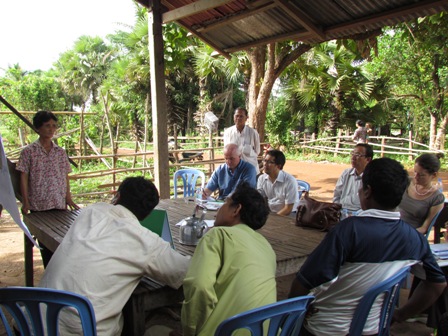In late May (23-25) 2012, CAFOD representatives, Mr. Geoff O’Donoghue, International Director Division; Mr. Francis Perez, SEA Regional Representative; Ms. Clodagh Byrne, Regional Programme Manager DRR/Livelihood, and Ms. Keo Kanaka, Regional Programme Officer for Cambodia/Philippines accompanied DPA’s Executive Director, Mr. Mam Sambath, ICD-Manager Mr. Lay Sophea, ICD-RTK Team Leader Mr. Khiev Sopheak, EI Impact officer Mr. Dara Rith, and Indigenous Community Support Organisation (ICSO)’s staff members on an expo-visit to Ratanakiri in the northeast of Cambodia which is one of DPA’s target areas. The objective of the visit was to observe good practices, key successes and challenges of the indigenous communities.
During the field visit, three villages were selected as focal villages. Two of them (Dey Lo and And La In) are located in DPA’s target areas and another (Bro Lae) is in the ICSO’s target area.
Bro Lae is recognised as a village which has been impacted by mining and, through experiences shared by the community, it was seen that the members were strongly involved in protecting their land through meeting with companies, preventing workers from clearing the land, gaining better knowledge about mining impact and having a strong desire to protect their land from being confiscated by Hoang Anh and Chea Chanrith company.
Dey Lo village was seen to have a well organised plan to deal with disaster risk reduction (DRR) since they found and cleared a safe place to deal with floods and mapped a nearby water source in order to deal with drought. All of this was integrated into their commune plan.
La In village is one of the three communal land titling (CLT) villages recognised by the government after working for this recognition for eight years, therefore bringing sustainable management for the land to La In’s villagers.
Mr. O’Donoghue said: “I appreciate Lumchhor community’s will in protecting their land from companies and their knowledge about the impact from mining. I also feel that Dey Lo community has a well organised plan to respond to disasters which are mostly caused by floods and drought. Also, La In’s achievement should be considered good practice so that other nearby villages can learn and practice CLT for sustainable land management. “
Ms. Byrne and Mr. Perez raised questions for the community to consider. In the case of Dey Lo community, they inquired about the key achievements and challenges in practicing their DRR annual plan. In response, Mrs. Van ChanKhern, DRR committee member, said “With regard to our annual plan, our community successfully implemented a number of plans, such as strengthening our community participation and knowledge, increasing rice production, identifying and clearing a safe place, and building good relationships with the DRR commune committee by integrating the DRR annual plan into the commune committee’s plan. However, we also faced some challenges of our own, such as lack of funds and equipment. In the case of lack of funds, we were helped by DPA which assisted us in forming a saving group.”
At the end of the trip, Mr. O’Donoghue was highly appreciative of the community’s achievements and challenges and provided suggestions and recommendations for them to respond to those challenges. He also expressed appreciation on DPA’s work from grassroots to provincial to national level as well as on their key achievements and committed to share these findings with other regions around the world.


